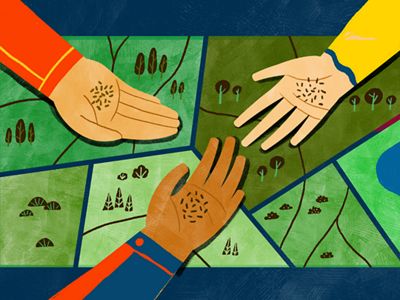
Prairie Diversity A diverse array of plants and animals contributes to a healthy prairie. © Richard Hamilton Smith
A few hundred years ago, South Dakota was covered in prairie. Buffalo roamed free, pollinators thrived on the nectar of wildflowers and birds nested in bunches of grass.
It wasn't just here. Rich grasslands once covered more than 700 million acres—or 31% of the United States. Now, much of that land has been converted for farming and development. This transformation has put grasslands and the many species it supports at risk.
Only 17% of prairie remains unplowed in the United States. Our rangeland here in South Dakota is 90% prairie. Landowners have many tools on hand to help restore grasslands and ensure their future.
Quote
Biodiversity is at the heart of this restorative process, supporting soil health and pollinator habitat, and landowners like you can make a difference, right where you are.
The role of biodiversity
Biodiversity is a good indicator of healthy lands. Short for “biological diversity,” biodiversity refers to the variety and variability of all living organisms in an ecosystem. In South Dakota, a healthy prairie with lots of biodiversity supports diverse types of plants, animals and micro-organisms.
There are three different aspects to prairie plant diversity a landowner should consider when working to improve the land: species diversity, genetic diversity and phylogenetic diversity.

Species diversity
Species diversity is higher when there are more species within the same ecosystem. So instead of planting only switchgrass, you might opt for several types of grass.
In South Dakota grasslands, consider planting a mix of grasses, like switchgrass, bluestem, grama or wheatgrass.

Genetic diversity
Genetic diversity is the genetic variation within a single species.
For example, if you want to plant a native species, like Prairie Coneflower, seek out seeds from different sources. Populations of plants growing at different sites are likely to have developed different characteristics that adapt them to that site, which equates to differences in their genetic diversity. Genetic diversity can make a population more resilient to disturbance or a changing climate.

Phylogenetic diversity
Phylogenetic diversity is an assessment of how species in a community are related to each other. Choosing species from distantly related plant families can improve how our ecosystem functions.
For example, instead of only planting different species of grasses, add a range of wildflowers, legumes or sedges. Many of our native grasslands had more than 400 plant species living together.

Building more resilient grasslands
It takes some thought and planning, but by practicing diverse planting on your land, you can be a vital part in building more resilient grasslands. You are investing in the future of this critical ecosystem, supporting the pollinators and species that bring the richness to the soil where we live and work, for future generations.
This project is made possible through a conservation cooperative agreement (NR216740XXXXG007) with the USDA Natural Resources Conservation Service serving South Dakota. Project sponsors include The Nature Conservancy, the USDA Natural Resources Conservation Service, the University of Arkansas, South Dakota State University Native Plant Initative and the U.S. Geological Survey.
We Can’t Save Nature Without You
Sign up to receive monthly conservation news and updates from South Dakota.



